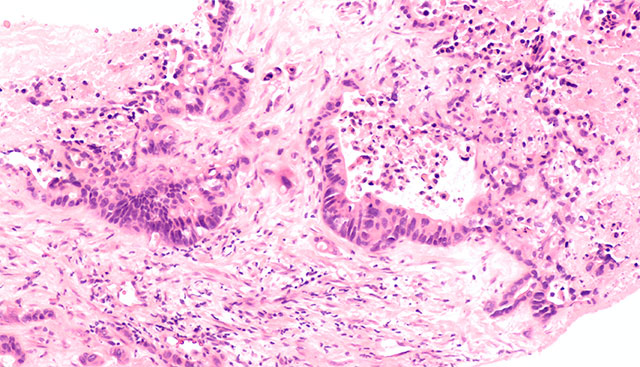
MRgSBRT Demonstrates Advantages in Treatment for Adrenal Gland Metastases
Dose-escalation has been shown to improve local control (LC) for adrenal gland metastases (AGM), however, the proximity of gastrointestinal (GI) structures limits the prescription dosage via CT-based stereotactic body radiation therapy (SGRT).
Dr. Matthew Mills, a radiation oncologist resident at Moffitt Cancer Center, presents research findings demonstrating the advantages of magnetic resonance guided SBRT (MRgSBRT), such as tumor tracking, treatment under breath hold, and online plan adaptation, creating the potential for safe dose escalation. The study investigates the efficacy and safety of MRgSBRT for the treatment of AGMs proven across various institutions.
The study included 57 consecutive cohorts who underwent MRgSBRT on a 0.35-T MR Linac to 61 AGMs from April 2019 to September 2021. Univariate analysis (UVA) with the Kaplan-Meier (KM) method was used to estimate time-to-event outcomes, including overall survival (OS), progression-free survival (PFS), and LC, with group differences compared by log-rank testing. Median follow-up was calculated with the reverse KM method.
Median follow-up was 12.2 months (95% CI 8.1-17.2 months). Median age at the time of SBRT was 67 years. Primary histologies included non-small cell lung cancer (N=38), renal cell carcinoma (N=6), and melanoma (N=5), amongst others. Most AGMs were left-sided (N=32) with a median maximum diameter of 2.7cm (range: 0.6-7.6cm) treated to a median total dose of 50 Gy (range: 30-60 Gy) in 5-10 fractions with a median BED10 100 Gy (range: 48-132 Gy). Forty-five cases (74%) required adaptation, more frequently in left-sided lesions due to the proximity of the stomach and small bowel (88% vs 59%). There were 3 cases of reirradiation, including 60 Gy in 10 fractions (N=1) and 40 Gy in 5 fractions (N=2). One-year LC, PFS, and OS were 90%, 40%, and 76%, respectively. On UVA, only melanoma histology predicted for inferior 1-year LC (53% vs 92%, p=0.022). The results present a nonsignificant improvement in LC for BED10 of 132 Gy (1-year LC 100% vs 87%, p=0.148). No patients who received BED10 132 Gy (N=13) experienced local failure. There were no cases of grade 3+ acute or late toxicity.
The early results demonstrated MRgSBRT achieves favorable LC and no grade 3+ toxicity despite prescribing a median BED10 of 100 Gy to targets in the proximity of GI organs at risk. Additionally, the unique advantages of MR guidance and online adaptive replanning may be especially beneficial for achieving safe dose escalation of radioresistant histologies such as melanoma.
Read Dr. Mills' complete ASTRO abstract.
If you’d like to refer a patient to Moffitt Cancer Center, complete our online form or contact a physician liaison for assistance. As part of our efforts to shorten referral times as much as possible, online referrals are typically responded to within 24 - 48 hours.
